Analysis of Lenovo's Transportation and Distribution Management Report
VerifiedAdded on 2020/04/21
|12
|2959
|75
Report
AI Summary
This report provides a comprehensive analysis of Lenovo's transportation and distribution management practices. It begins with an introduction to the importance of effective transportation in international business, particularly for a company like Lenovo that operates globally and faces intense competition. The report examines Lenovo's existing transportation processes, including its use of third-party logistics and supply chain software. It identifies key issues such as rising transportation costs and a lack of direct control. The report recommends specific incoterms, including Cost and Freight (CFR) and Delivered at Place (DAP), suitable for Lenovo's shipping needs. It outlines Lenovo's transportation goals, emphasizing safe, timely, and cost-effective product delivery. The report then details the criteria for selecting a carrier, including geographical coverage, equipment availability, transit time, and pickup/delivery reliability. Finally, it discusses carrier relationship management, recommending long-term relationships built on trust, shared profitability, and commitment management to enhance collaboration between Lenovo and its shipping partners. The report concludes by emphasizing the importance of these recommendations for improving Lenovo's transportation efficiency and reducing costs.
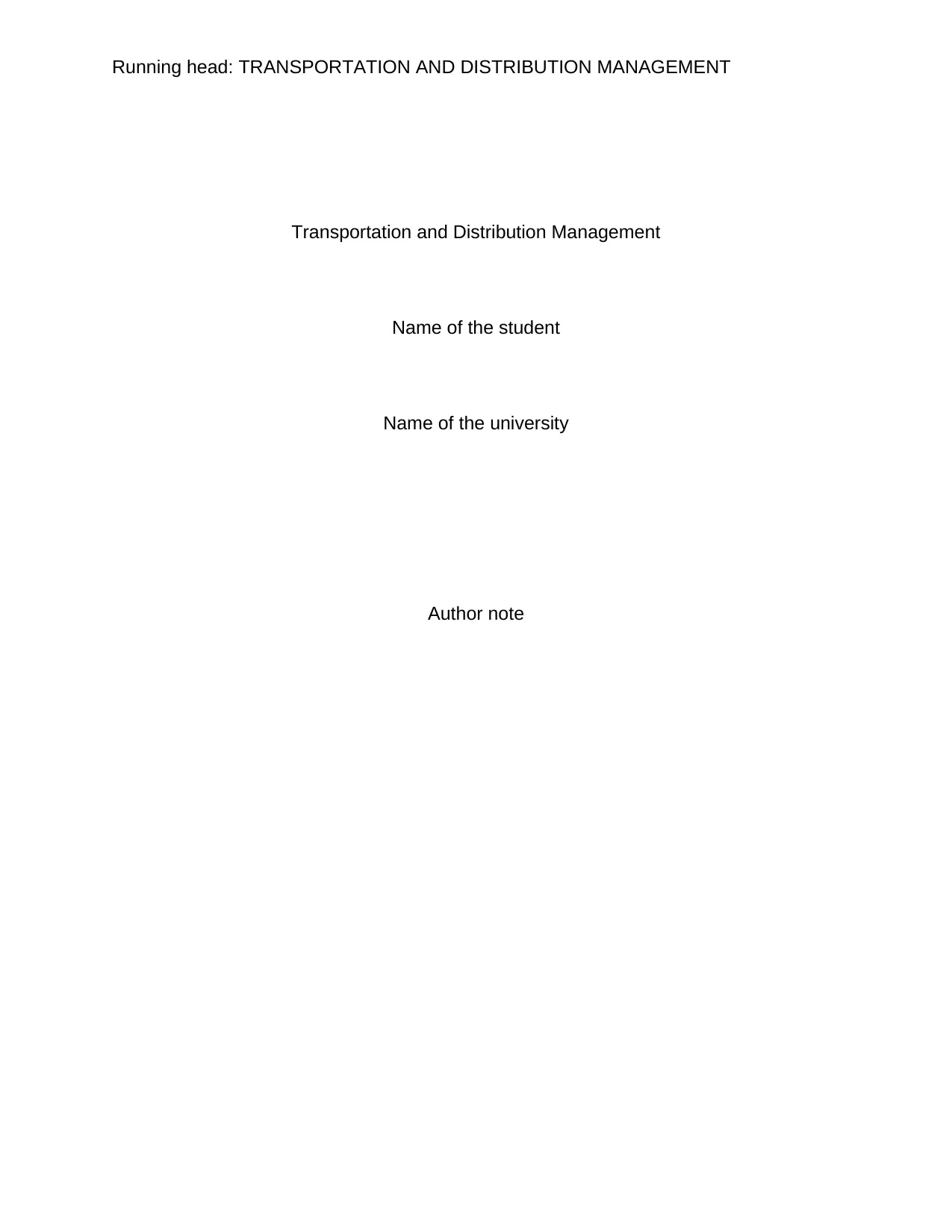
Running head: TRANSPORTATION AND DISTRIBUTION MANAGEMENT
Transportation and Distribution Management
Name of the student
Name of the university
Author note
Transportation and Distribution Management
Name of the student
Name of the university
Author note
Paraphrase This Document
Need a fresh take? Get an instant paraphrase of this document with our AI Paraphraser
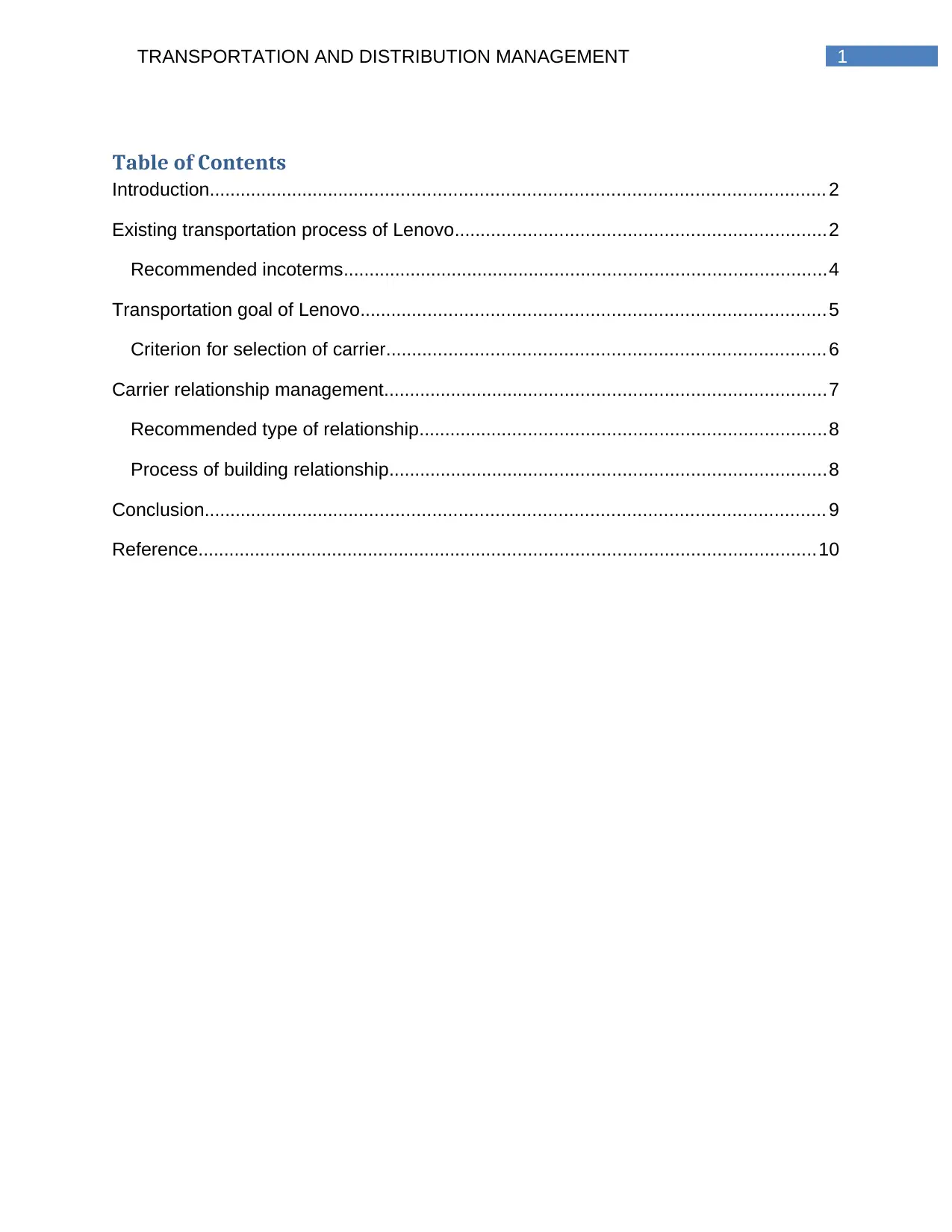
1TRANSPORTATION AND DISTRIBUTION MANAGEMENT
Table of Contents
Introduction...................................................................................................................... 2
Existing transportation process of Lenovo.......................................................................2
Recommended incoterms.............................................................................................4
Transportation goal of Lenovo.........................................................................................5
Criterion for selection of carrier.................................................................................... 6
Carrier relationship management.....................................................................................7
Recommended type of relationship..............................................................................8
Process of building relationship....................................................................................8
Conclusion....................................................................................................................... 9
Reference.......................................................................................................................10
Table of Contents
Introduction...................................................................................................................... 2
Existing transportation process of Lenovo.......................................................................2
Recommended incoterms.............................................................................................4
Transportation goal of Lenovo.........................................................................................5
Criterion for selection of carrier.................................................................................... 6
Carrier relationship management.....................................................................................7
Recommended type of relationship..............................................................................8
Process of building relationship....................................................................................8
Conclusion....................................................................................................................... 9
Reference.......................................................................................................................10
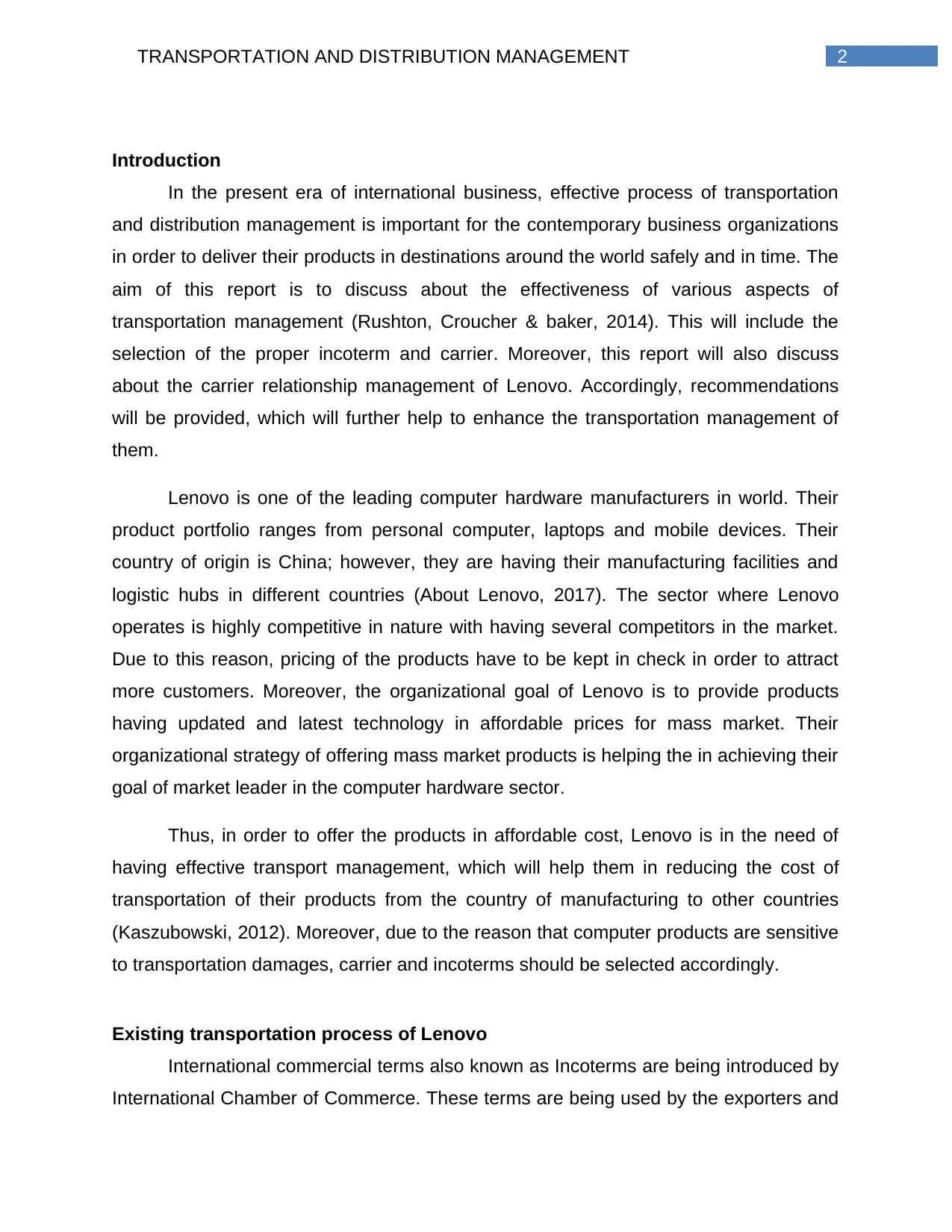
2TRANSPORTATION AND DISTRIBUTION MANAGEMENT
Introduction
In the present era of international business, effective process of transportation
and distribution management is important for the contemporary business organizations
in order to deliver their products in destinations around the world safely and in time. The
aim of this report is to discuss about the effectiveness of various aspects of
transportation management (Rushton, Croucher & baker, 2014). This will include the
selection of the proper incoterm and carrier. Moreover, this report will also discuss
about the carrier relationship management of Lenovo. Accordingly, recommendations
will be provided, which will further help to enhance the transportation management of
them.
Lenovo is one of the leading computer hardware manufacturers in world. Their
product portfolio ranges from personal computer, laptops and mobile devices. Their
country of origin is China; however, they are having their manufacturing facilities and
logistic hubs in different countries (About Lenovo, 2017). The sector where Lenovo
operates is highly competitive in nature with having several competitors in the market.
Due to this reason, pricing of the products have to be kept in check in order to attract
more customers. Moreover, the organizational goal of Lenovo is to provide products
having updated and latest technology in affordable prices for mass market. Their
organizational strategy of offering mass market products is helping the in achieving their
goal of market leader in the computer hardware sector.
Thus, in order to offer the products in affordable cost, Lenovo is in the need of
having effective transport management, which will help them in reducing the cost of
transportation of their products from the country of manufacturing to other countries
(Kaszubowski, 2012). Moreover, due to the reason that computer products are sensitive
to transportation damages, carrier and incoterms should be selected accordingly.
Existing transportation process of Lenovo
International commercial terms also known as Incoterms are being introduced by
International Chamber of Commerce. These terms are being used by the exporters and
Introduction
In the present era of international business, effective process of transportation
and distribution management is important for the contemporary business organizations
in order to deliver their products in destinations around the world safely and in time. The
aim of this report is to discuss about the effectiveness of various aspects of
transportation management (Rushton, Croucher & baker, 2014). This will include the
selection of the proper incoterm and carrier. Moreover, this report will also discuss
about the carrier relationship management of Lenovo. Accordingly, recommendations
will be provided, which will further help to enhance the transportation management of
them.
Lenovo is one of the leading computer hardware manufacturers in world. Their
product portfolio ranges from personal computer, laptops and mobile devices. Their
country of origin is China; however, they are having their manufacturing facilities and
logistic hubs in different countries (About Lenovo, 2017). The sector where Lenovo
operates is highly competitive in nature with having several competitors in the market.
Due to this reason, pricing of the products have to be kept in check in order to attract
more customers. Moreover, the organizational goal of Lenovo is to provide products
having updated and latest technology in affordable prices for mass market. Their
organizational strategy of offering mass market products is helping the in achieving their
goal of market leader in the computer hardware sector.
Thus, in order to offer the products in affordable cost, Lenovo is in the need of
having effective transport management, which will help them in reducing the cost of
transportation of their products from the country of manufacturing to other countries
(Kaszubowski, 2012). Moreover, due to the reason that computer products are sensitive
to transportation damages, carrier and incoterms should be selected accordingly.
Existing transportation process of Lenovo
International commercial terms also known as Incoterms are being introduced by
International Chamber of Commerce. These terms are being used by the exporters and
⊘ This is a preview!⊘
Do you want full access?
Subscribe today to unlock all pages.

Trusted by 1+ million students worldwide
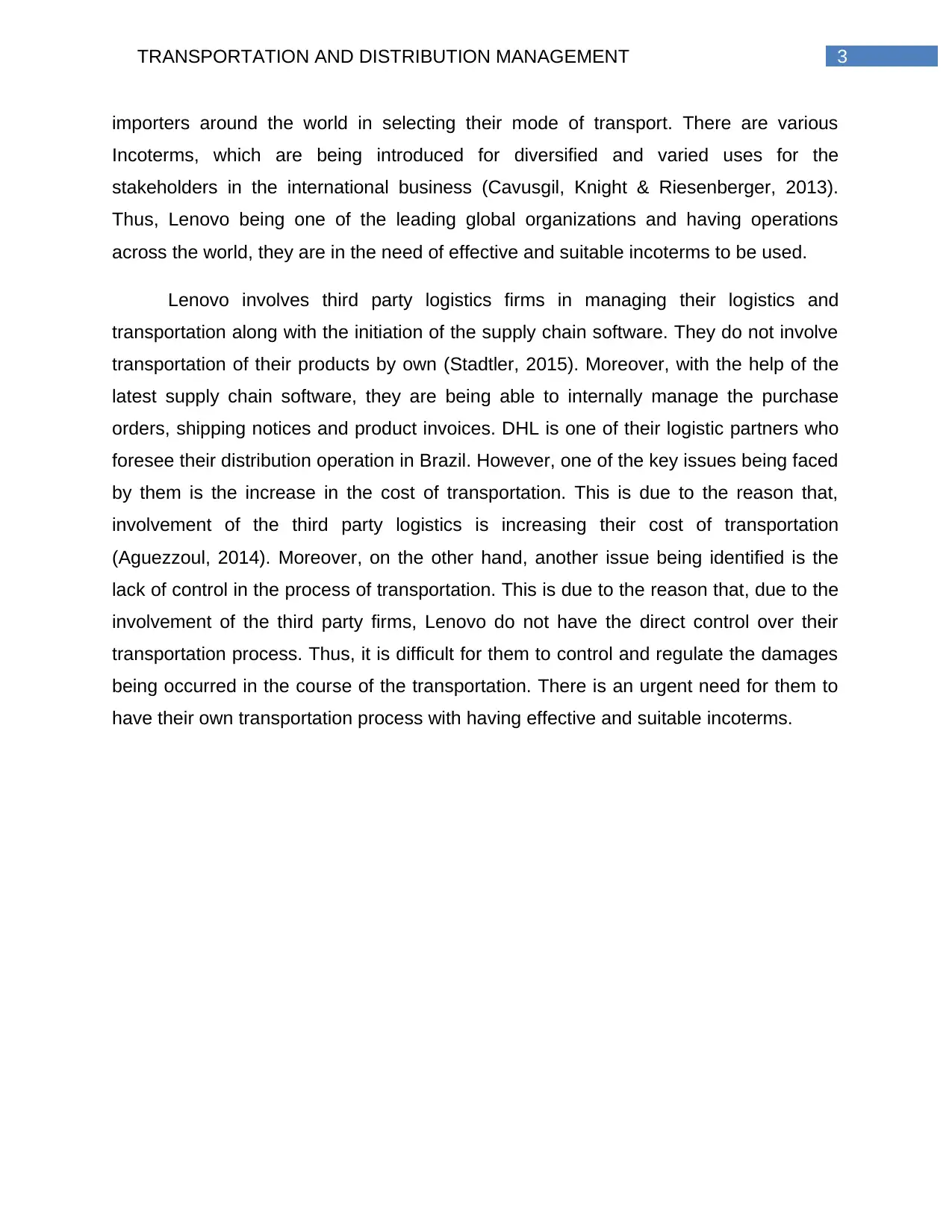
3TRANSPORTATION AND DISTRIBUTION MANAGEMENT
importers around the world in selecting their mode of transport. There are various
Incoterms, which are being introduced for diversified and varied uses for the
stakeholders in the international business (Cavusgil, Knight & Riesenberger, 2013).
Thus, Lenovo being one of the leading global organizations and having operations
across the world, they are in the need of effective and suitable incoterms to be used.
Lenovo involves third party logistics firms in managing their logistics and
transportation along with the initiation of the supply chain software. They do not involve
transportation of their products by own (Stadtler, 2015). Moreover, with the help of the
latest supply chain software, they are being able to internally manage the purchase
orders, shipping notices and product invoices. DHL is one of their logistic partners who
foresee their distribution operation in Brazil. However, one of the key issues being faced
by them is the increase in the cost of transportation. This is due to the reason that,
involvement of the third party logistics is increasing their cost of transportation
(Aguezzoul, 2014). Moreover, on the other hand, another issue being identified is the
lack of control in the process of transportation. This is due to the reason that, due to the
involvement of the third party firms, Lenovo do not have the direct control over their
transportation process. Thus, it is difficult for them to control and regulate the damages
being occurred in the course of the transportation. There is an urgent need for them to
have their own transportation process with having effective and suitable incoterms.
importers around the world in selecting their mode of transport. There are various
Incoterms, which are being introduced for diversified and varied uses for the
stakeholders in the international business (Cavusgil, Knight & Riesenberger, 2013).
Thus, Lenovo being one of the leading global organizations and having operations
across the world, they are in the need of effective and suitable incoterms to be used.
Lenovo involves third party logistics firms in managing their logistics and
transportation along with the initiation of the supply chain software. They do not involve
transportation of their products by own (Stadtler, 2015). Moreover, with the help of the
latest supply chain software, they are being able to internally manage the purchase
orders, shipping notices and product invoices. DHL is one of their logistic partners who
foresee their distribution operation in Brazil. However, one of the key issues being faced
by them is the increase in the cost of transportation. This is due to the reason that,
involvement of the third party logistics is increasing their cost of transportation
(Aguezzoul, 2014). Moreover, on the other hand, another issue being identified is the
lack of control in the process of transportation. This is due to the reason that, due to the
involvement of the third party firms, Lenovo do not have the direct control over their
transportation process. Thus, it is difficult for them to control and regulate the damages
being occurred in the course of the transportation. There is an urgent need for them to
have their own transportation process with having effective and suitable incoterms.
Paraphrase This Document
Need a fresh take? Get an instant paraphrase of this document with our AI Paraphraser
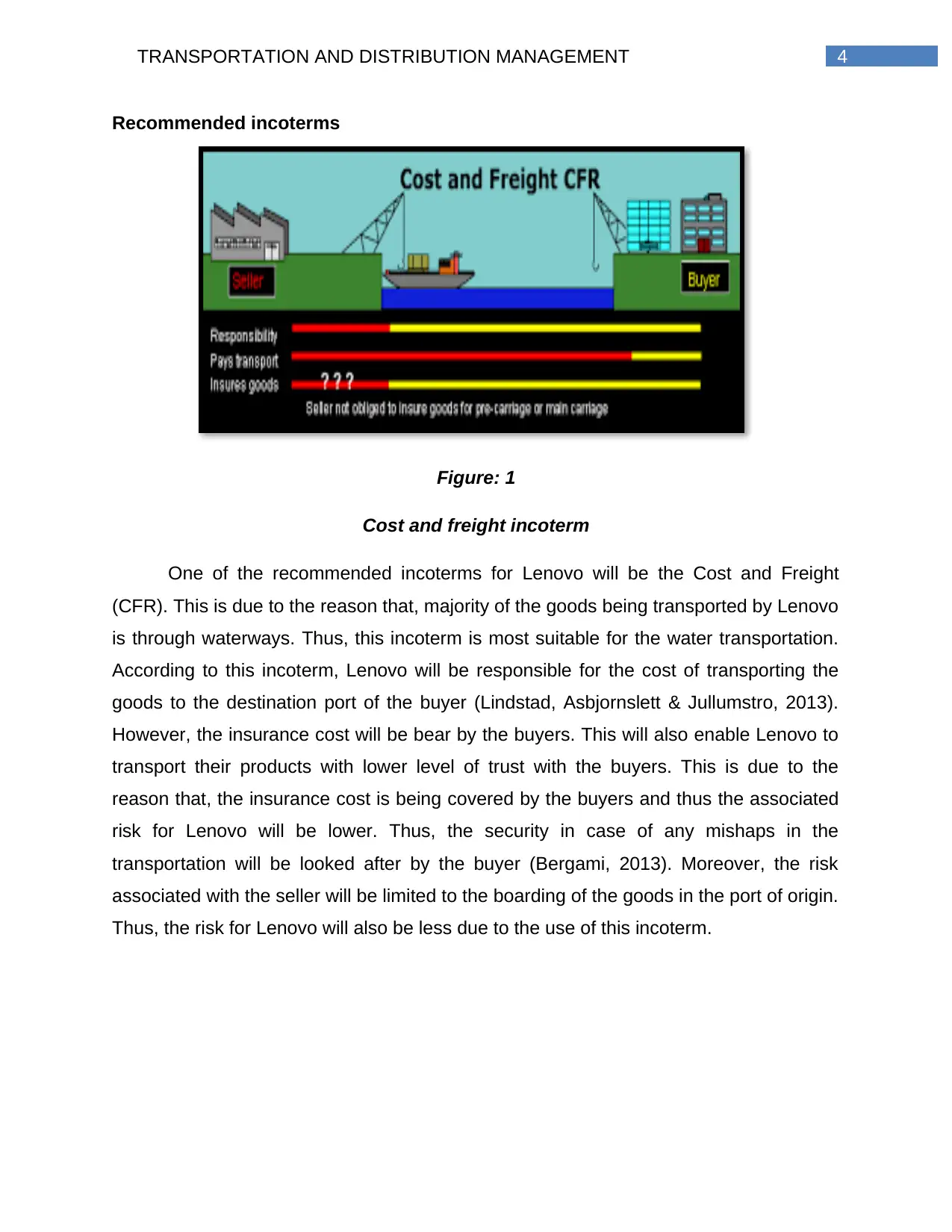
4TRANSPORTATION AND DISTRIBUTION MANAGEMENT
Recommended incoterms
Figure: 1
Cost and freight incoterm
One of the recommended incoterms for Lenovo will be the Cost and Freight
(CFR). This is due to the reason that, majority of the goods being transported by Lenovo
is through waterways. Thus, this incoterm is most suitable for the water transportation.
According to this incoterm, Lenovo will be responsible for the cost of transporting the
goods to the destination port of the buyer (Lindstad, Asbjornslett & Jullumstro, 2013).
However, the insurance cost will be bear by the buyers. This will also enable Lenovo to
transport their products with lower level of trust with the buyers. This is due to the
reason that, the insurance cost is being covered by the buyers and thus the associated
risk for Lenovo will be lower. Thus, the security in case of any mishaps in the
transportation will be looked after by the buyer (Bergami, 2013). Moreover, the risk
associated with the seller will be limited to the boarding of the goods in the port of origin.
Thus, the risk for Lenovo will also be less due to the use of this incoterm.
Recommended incoterms
Figure: 1
Cost and freight incoterm
One of the recommended incoterms for Lenovo will be the Cost and Freight
(CFR). This is due to the reason that, majority of the goods being transported by Lenovo
is through waterways. Thus, this incoterm is most suitable for the water transportation.
According to this incoterm, Lenovo will be responsible for the cost of transporting the
goods to the destination port of the buyer (Lindstad, Asbjornslett & Jullumstro, 2013).
However, the insurance cost will be bear by the buyers. This will also enable Lenovo to
transport their products with lower level of trust with the buyers. This is due to the
reason that, the insurance cost is being covered by the buyers and thus the associated
risk for Lenovo will be lower. Thus, the security in case of any mishaps in the
transportation will be looked after by the buyer (Bergami, 2013). Moreover, the risk
associated with the seller will be limited to the boarding of the goods in the port of origin.
Thus, the risk for Lenovo will also be less due to the use of this incoterm.
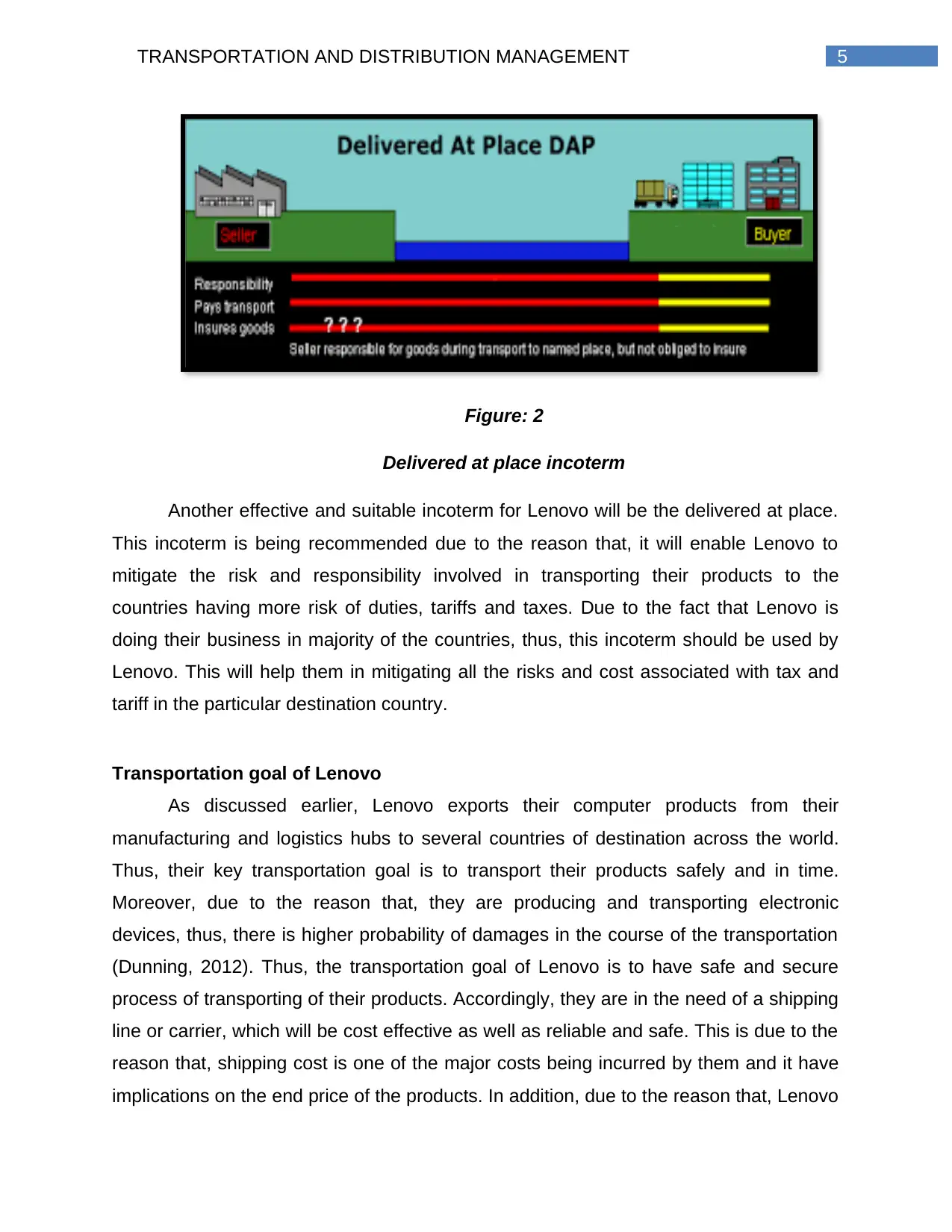
5TRANSPORTATION AND DISTRIBUTION MANAGEMENT
Figure: 2
Delivered at place incoterm
Another effective and suitable incoterm for Lenovo will be the delivered at place.
This incoterm is being recommended due to the reason that, it will enable Lenovo to
mitigate the risk and responsibility involved in transporting their products to the
countries having more risk of duties, tariffs and taxes. Due to the fact that Lenovo is
doing their business in majority of the countries, thus, this incoterm should be used by
Lenovo. This will help them in mitigating all the risks and cost associated with tax and
tariff in the particular destination country.
Transportation goal of Lenovo
As discussed earlier, Lenovo exports their computer products from their
manufacturing and logistics hubs to several countries of destination across the world.
Thus, their key transportation goal is to transport their products safely and in time.
Moreover, due to the reason that, they are producing and transporting electronic
devices, thus, there is higher probability of damages in the course of the transportation
(Dunning, 2012). Thus, the transportation goal of Lenovo is to have safe and secure
process of transporting of their products. Accordingly, they are in the need of a shipping
line or carrier, which will be cost effective as well as reliable and safe. This is due to the
reason that, shipping cost is one of the major costs being incurred by them and it have
implications on the end price of the products. In addition, due to the reason that, Lenovo
Figure: 2
Delivered at place incoterm
Another effective and suitable incoterm for Lenovo will be the delivered at place.
This incoterm is being recommended due to the reason that, it will enable Lenovo to
mitigate the risk and responsibility involved in transporting their products to the
countries having more risk of duties, tariffs and taxes. Due to the fact that Lenovo is
doing their business in majority of the countries, thus, this incoterm should be used by
Lenovo. This will help them in mitigating all the risks and cost associated with tax and
tariff in the particular destination country.
Transportation goal of Lenovo
As discussed earlier, Lenovo exports their computer products from their
manufacturing and logistics hubs to several countries of destination across the world.
Thus, their key transportation goal is to transport their products safely and in time.
Moreover, due to the reason that, they are producing and transporting electronic
devices, thus, there is higher probability of damages in the course of the transportation
(Dunning, 2012). Thus, the transportation goal of Lenovo is to have safe and secure
process of transporting of their products. Accordingly, they are in the need of a shipping
line or carrier, which will be cost effective as well as reliable and safe. This is due to the
reason that, shipping cost is one of the major costs being incurred by them and it have
implications on the end price of the products. In addition, due to the reason that, Lenovo
⊘ This is a preview!⊘
Do you want full access?
Subscribe today to unlock all pages.

Trusted by 1+ million students worldwide
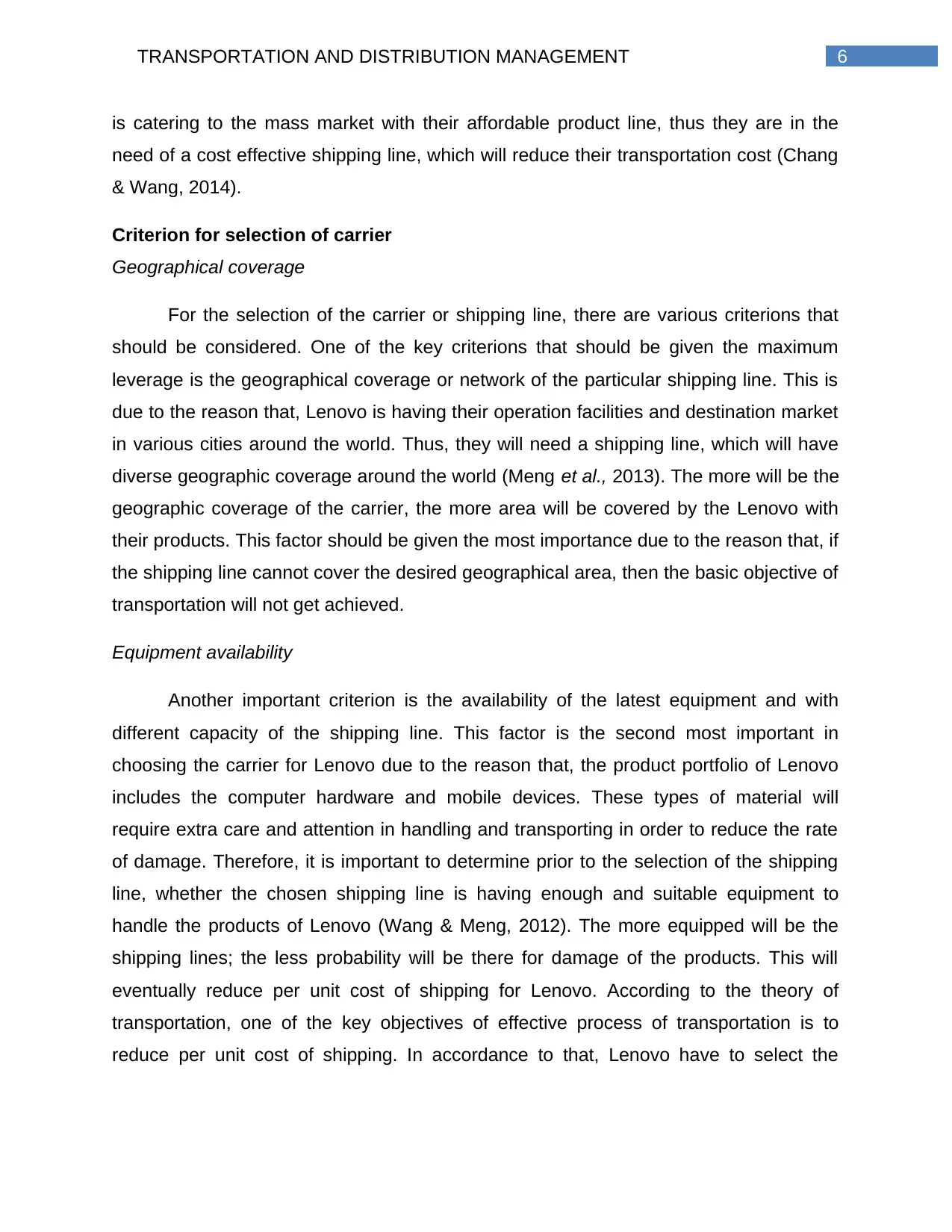
6TRANSPORTATION AND DISTRIBUTION MANAGEMENT
is catering to the mass market with their affordable product line, thus they are in the
need of a cost effective shipping line, which will reduce their transportation cost (Chang
& Wang, 2014).
Criterion for selection of carrier
Geographical coverage
For the selection of the carrier or shipping line, there are various criterions that
should be considered. One of the key criterions that should be given the maximum
leverage is the geographical coverage or network of the particular shipping line. This is
due to the reason that, Lenovo is having their operation facilities and destination market
in various cities around the world. Thus, they will need a shipping line, which will have
diverse geographic coverage around the world (Meng et al., 2013). The more will be the
geographic coverage of the carrier, the more area will be covered by the Lenovo with
their products. This factor should be given the most importance due to the reason that, if
the shipping line cannot cover the desired geographical area, then the basic objective of
transportation will not get achieved.
Equipment availability
Another important criterion is the availability of the latest equipment and with
different capacity of the shipping line. This factor is the second most important in
choosing the carrier for Lenovo due to the reason that, the product portfolio of Lenovo
includes the computer hardware and mobile devices. These types of material will
require extra care and attention in handling and transporting in order to reduce the rate
of damage. Therefore, it is important to determine prior to the selection of the shipping
line, whether the chosen shipping line is having enough and suitable equipment to
handle the products of Lenovo (Wang & Meng, 2012). The more equipped will be the
shipping lines; the less probability will be there for damage of the products. This will
eventually reduce per unit cost of shipping for Lenovo. According to the theory of
transportation, one of the key objectives of effective process of transportation is to
reduce per unit cost of shipping. In accordance to that, Lenovo have to select the
is catering to the mass market with their affordable product line, thus they are in the
need of a cost effective shipping line, which will reduce their transportation cost (Chang
& Wang, 2014).
Criterion for selection of carrier
Geographical coverage
For the selection of the carrier or shipping line, there are various criterions that
should be considered. One of the key criterions that should be given the maximum
leverage is the geographical coverage or network of the particular shipping line. This is
due to the reason that, Lenovo is having their operation facilities and destination market
in various cities around the world. Thus, they will need a shipping line, which will have
diverse geographic coverage around the world (Meng et al., 2013). The more will be the
geographic coverage of the carrier, the more area will be covered by the Lenovo with
their products. This factor should be given the most importance due to the reason that, if
the shipping line cannot cover the desired geographical area, then the basic objective of
transportation will not get achieved.
Equipment availability
Another important criterion is the availability of the latest equipment and with
different capacity of the shipping line. This factor is the second most important in
choosing the carrier for Lenovo due to the reason that, the product portfolio of Lenovo
includes the computer hardware and mobile devices. These types of material will
require extra care and attention in handling and transporting in order to reduce the rate
of damage. Therefore, it is important to determine prior to the selection of the shipping
line, whether the chosen shipping line is having enough and suitable equipment to
handle the products of Lenovo (Wang & Meng, 2012). The more equipped will be the
shipping lines; the less probability will be there for damage of the products. This will
eventually reduce per unit cost of shipping for Lenovo. According to the theory of
transportation, one of the key objectives of effective process of transportation is to
reduce per unit cost of shipping. In accordance to that, Lenovo have to select the
Paraphrase This Document
Need a fresh take? Get an instant paraphrase of this document with our AI Paraphraser
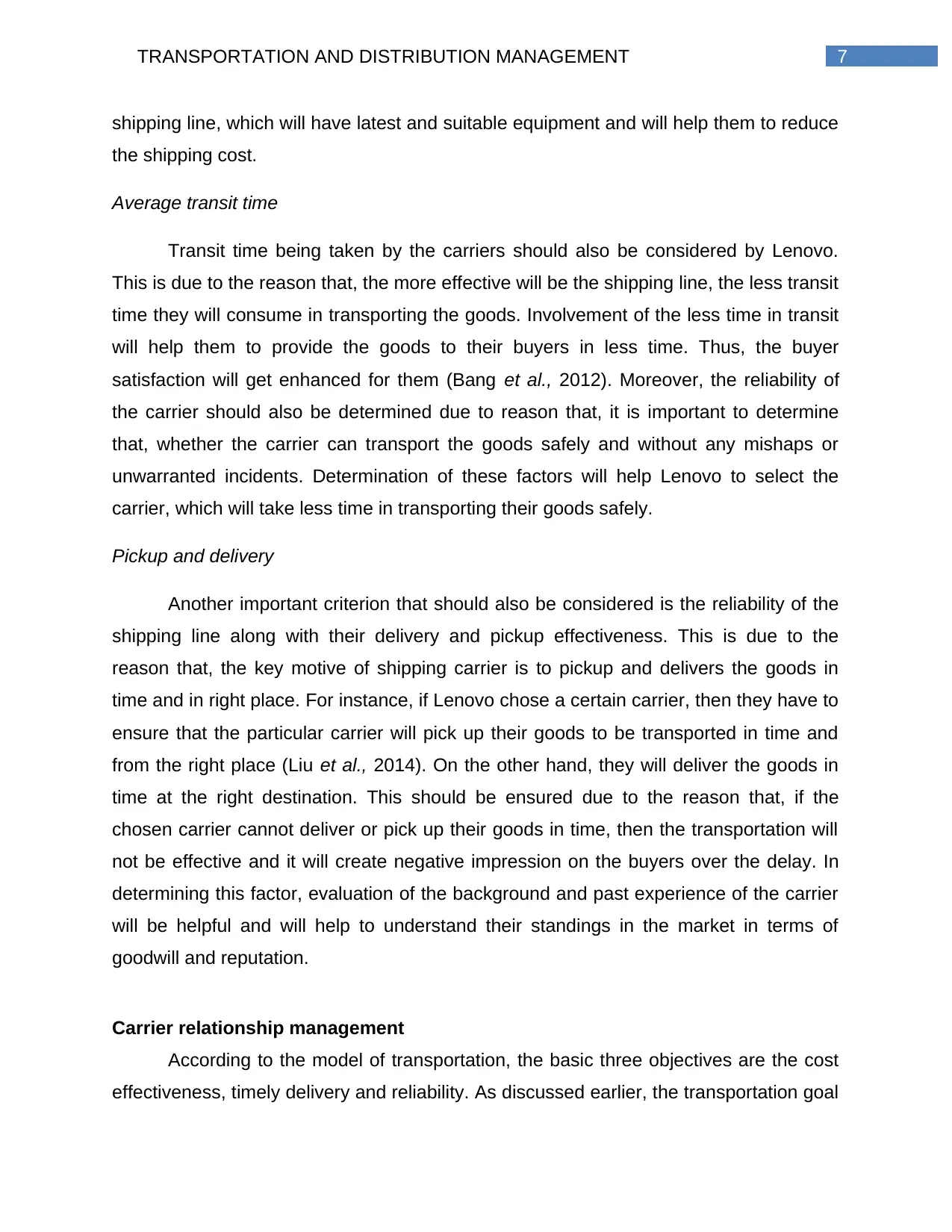
7TRANSPORTATION AND DISTRIBUTION MANAGEMENT
shipping line, which will have latest and suitable equipment and will help them to reduce
the shipping cost.
Average transit time
Transit time being taken by the carriers should also be considered by Lenovo.
This is due to the reason that, the more effective will be the shipping line, the less transit
time they will consume in transporting the goods. Involvement of the less time in transit
will help them to provide the goods to their buyers in less time. Thus, the buyer
satisfaction will get enhanced for them (Bang et al., 2012). Moreover, the reliability of
the carrier should also be determined due to reason that, it is important to determine
that, whether the carrier can transport the goods safely and without any mishaps or
unwarranted incidents. Determination of these factors will help Lenovo to select the
carrier, which will take less time in transporting their goods safely.
Pickup and delivery
Another important criterion that should also be considered is the reliability of the
shipping line along with their delivery and pickup effectiveness. This is due to the
reason that, the key motive of shipping carrier is to pickup and delivers the goods in
time and in right place. For instance, if Lenovo chose a certain carrier, then they have to
ensure that the particular carrier will pick up their goods to be transported in time and
from the right place (Liu et al., 2014). On the other hand, they will deliver the goods in
time at the right destination. This should be ensured due to the reason that, if the
chosen carrier cannot deliver or pick up their goods in time, then the transportation will
not be effective and it will create negative impression on the buyers over the delay. In
determining this factor, evaluation of the background and past experience of the carrier
will be helpful and will help to understand their standings in the market in terms of
goodwill and reputation.
Carrier relationship management
According to the model of transportation, the basic three objectives are the cost
effectiveness, timely delivery and reliability. As discussed earlier, the transportation goal
shipping line, which will have latest and suitable equipment and will help them to reduce
the shipping cost.
Average transit time
Transit time being taken by the carriers should also be considered by Lenovo.
This is due to the reason that, the more effective will be the shipping line, the less transit
time they will consume in transporting the goods. Involvement of the less time in transit
will help them to provide the goods to their buyers in less time. Thus, the buyer
satisfaction will get enhanced for them (Bang et al., 2012). Moreover, the reliability of
the carrier should also be determined due to reason that, it is important to determine
that, whether the carrier can transport the goods safely and without any mishaps or
unwarranted incidents. Determination of these factors will help Lenovo to select the
carrier, which will take less time in transporting their goods safely.
Pickup and delivery
Another important criterion that should also be considered is the reliability of the
shipping line along with their delivery and pickup effectiveness. This is due to the
reason that, the key motive of shipping carrier is to pickup and delivers the goods in
time and in right place. For instance, if Lenovo chose a certain carrier, then they have to
ensure that the particular carrier will pick up their goods to be transported in time and
from the right place (Liu et al., 2014). On the other hand, they will deliver the goods in
time at the right destination. This should be ensured due to the reason that, if the
chosen carrier cannot deliver or pick up their goods in time, then the transportation will
not be effective and it will create negative impression on the buyers over the delay. In
determining this factor, evaluation of the background and past experience of the carrier
will be helpful and will help to understand their standings in the market in terms of
goodwill and reputation.
Carrier relationship management
According to the model of transportation, the basic three objectives are the cost
effectiveness, timely delivery and reliability. As discussed earlier, the transportation goal
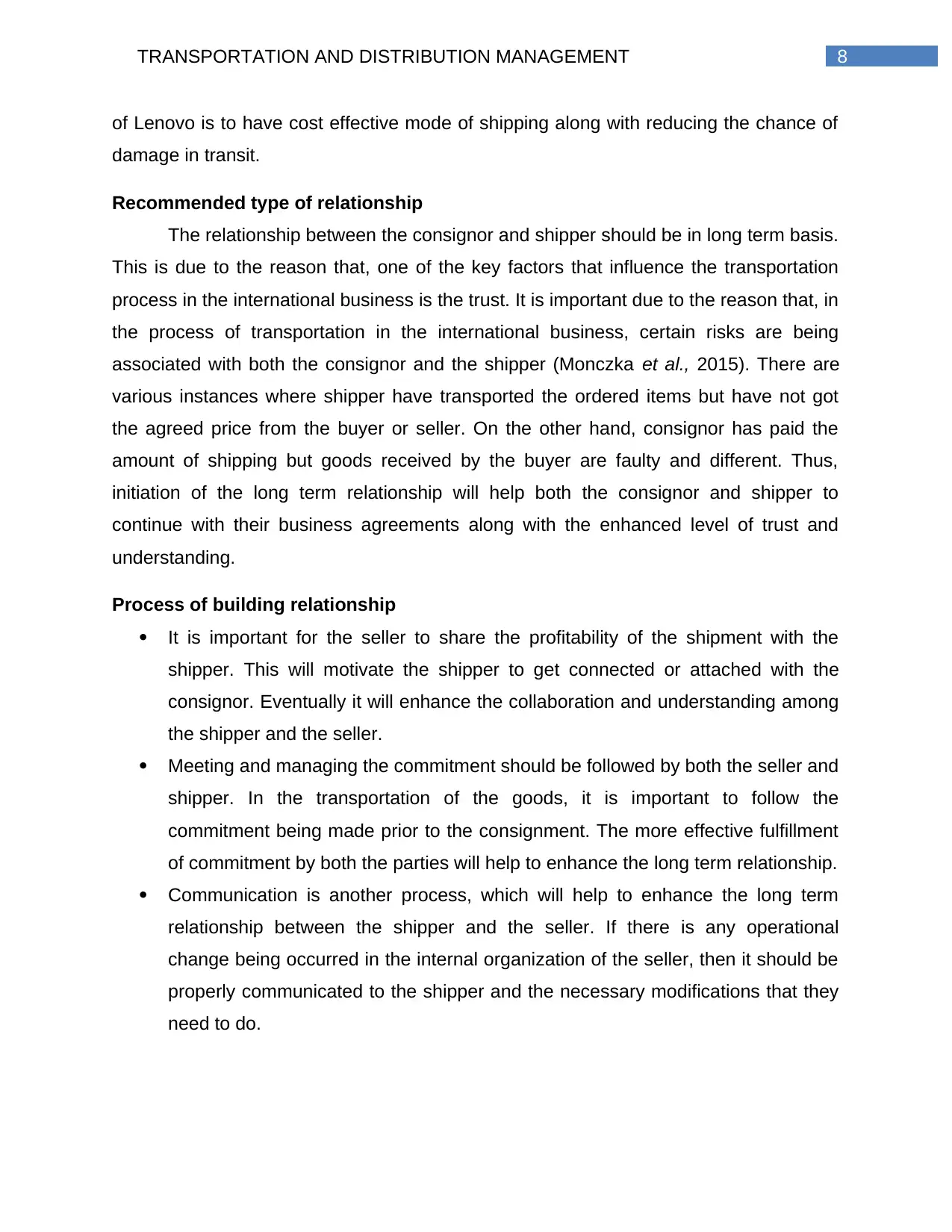
8TRANSPORTATION AND DISTRIBUTION MANAGEMENT
of Lenovo is to have cost effective mode of shipping along with reducing the chance of
damage in transit.
Recommended type of relationship
The relationship between the consignor and shipper should be in long term basis.
This is due to the reason that, one of the key factors that influence the transportation
process in the international business is the trust. It is important due to the reason that, in
the process of transportation in the international business, certain risks are being
associated with both the consignor and the shipper (Monczka et al., 2015). There are
various instances where shipper have transported the ordered items but have not got
the agreed price from the buyer or seller. On the other hand, consignor has paid the
amount of shipping but goods received by the buyer are faulty and different. Thus,
initiation of the long term relationship will help both the consignor and shipper to
continue with their business agreements along with the enhanced level of trust and
understanding.
Process of building relationship
It is important for the seller to share the profitability of the shipment with the
shipper. This will motivate the shipper to get connected or attached with the
consignor. Eventually it will enhance the collaboration and understanding among
the shipper and the seller.
Meeting and managing the commitment should be followed by both the seller and
shipper. In the transportation of the goods, it is important to follow the
commitment being made prior to the consignment. The more effective fulfillment
of commitment by both the parties will help to enhance the long term relationship.
Communication is another process, which will help to enhance the long term
relationship between the shipper and the seller. If there is any operational
change being occurred in the internal organization of the seller, then it should be
properly communicated to the shipper and the necessary modifications that they
need to do.
of Lenovo is to have cost effective mode of shipping along with reducing the chance of
damage in transit.
Recommended type of relationship
The relationship between the consignor and shipper should be in long term basis.
This is due to the reason that, one of the key factors that influence the transportation
process in the international business is the trust. It is important due to the reason that, in
the process of transportation in the international business, certain risks are being
associated with both the consignor and the shipper (Monczka et al., 2015). There are
various instances where shipper have transported the ordered items but have not got
the agreed price from the buyer or seller. On the other hand, consignor has paid the
amount of shipping but goods received by the buyer are faulty and different. Thus,
initiation of the long term relationship will help both the consignor and shipper to
continue with their business agreements along with the enhanced level of trust and
understanding.
Process of building relationship
It is important for the seller to share the profitability of the shipment with the
shipper. This will motivate the shipper to get connected or attached with the
consignor. Eventually it will enhance the collaboration and understanding among
the shipper and the seller.
Meeting and managing the commitment should be followed by both the seller and
shipper. In the transportation of the goods, it is important to follow the
commitment being made prior to the consignment. The more effective fulfillment
of commitment by both the parties will help to enhance the long term relationship.
Communication is another process, which will help to enhance the long term
relationship between the shipper and the seller. If there is any operational
change being occurred in the internal organization of the seller, then it should be
properly communicated to the shipper and the necessary modifications that they
need to do.
⊘ This is a preview!⊘
Do you want full access?
Subscribe today to unlock all pages.

Trusted by 1+ million students worldwide
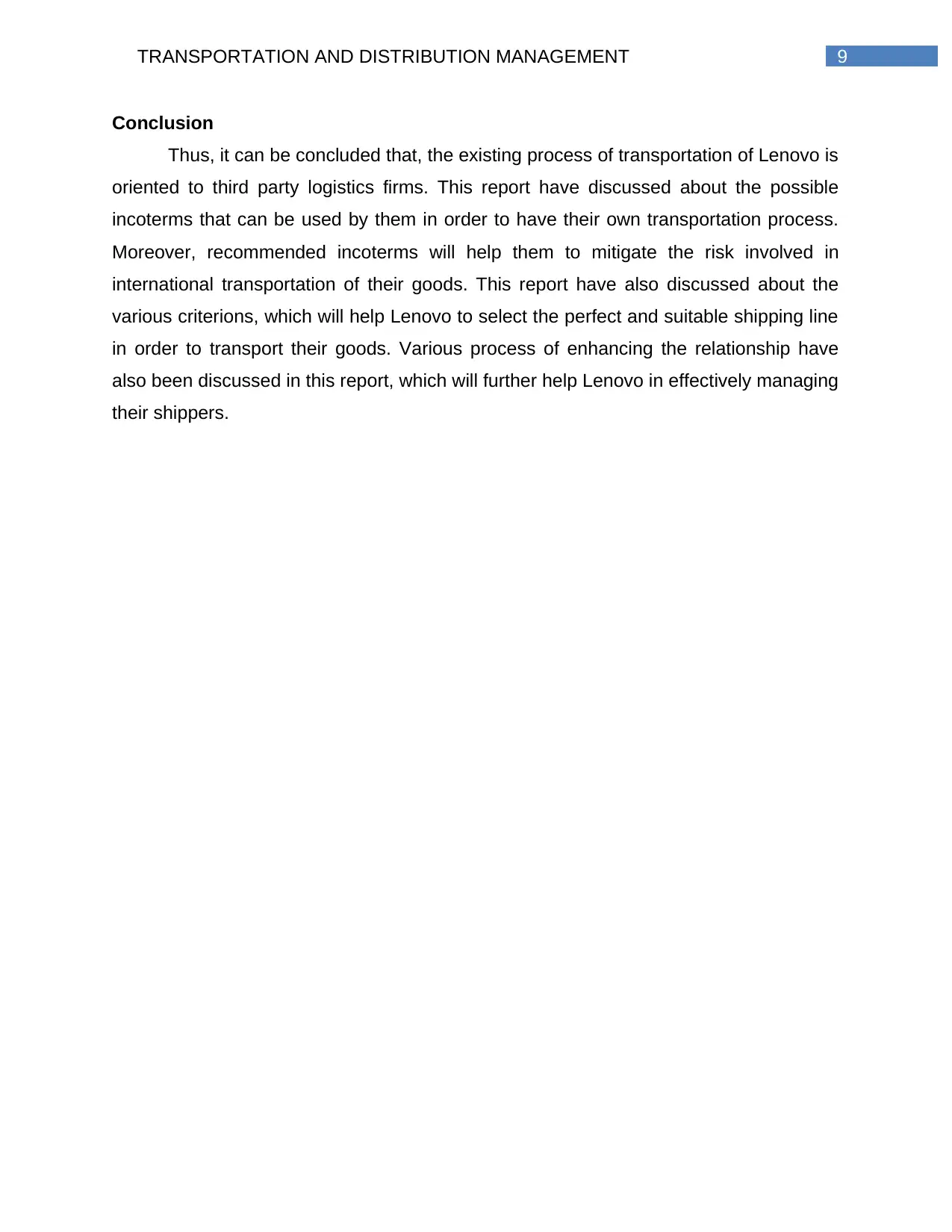
9TRANSPORTATION AND DISTRIBUTION MANAGEMENT
Conclusion
Thus, it can be concluded that, the existing process of transportation of Lenovo is
oriented to third party logistics firms. This report have discussed about the possible
incoterms that can be used by them in order to have their own transportation process.
Moreover, recommended incoterms will help them to mitigate the risk involved in
international transportation of their goods. This report have also discussed about the
various criterions, which will help Lenovo to select the perfect and suitable shipping line
in order to transport their goods. Various process of enhancing the relationship have
also been discussed in this report, which will further help Lenovo in effectively managing
their shippers.
Conclusion
Thus, it can be concluded that, the existing process of transportation of Lenovo is
oriented to third party logistics firms. This report have discussed about the possible
incoterms that can be used by them in order to have their own transportation process.
Moreover, recommended incoterms will help them to mitigate the risk involved in
international transportation of their goods. This report have also discussed about the
various criterions, which will help Lenovo to select the perfect and suitable shipping line
in order to transport their goods. Various process of enhancing the relationship have
also been discussed in this report, which will further help Lenovo in effectively managing
their shippers.
Paraphrase This Document
Need a fresh take? Get an instant paraphrase of this document with our AI Paraphraser
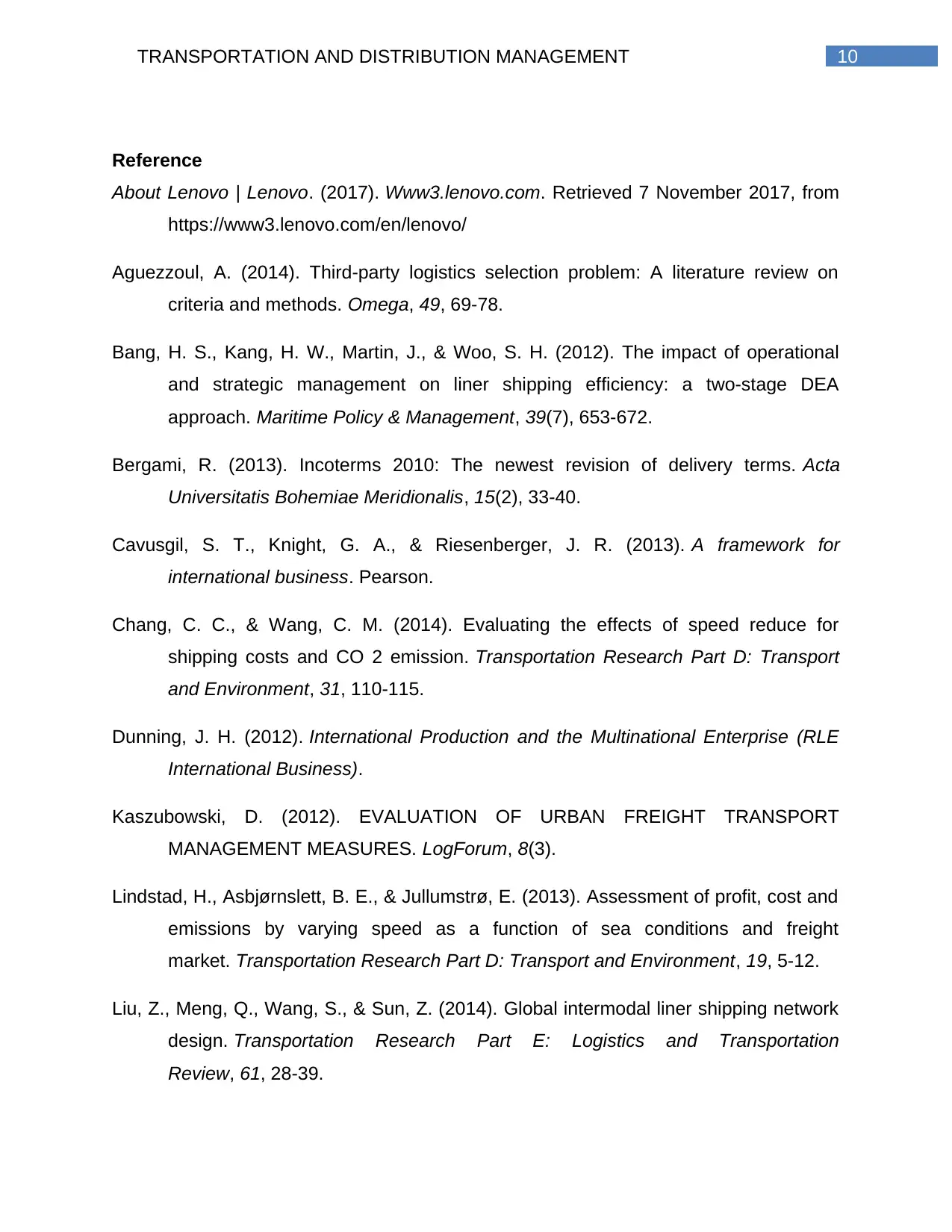
10TRANSPORTATION AND DISTRIBUTION MANAGEMENT
Reference
About Lenovo | Lenovo. (2017). Www3.lenovo.com. Retrieved 7 November 2017, from
https://www3.lenovo.com/en/lenovo/
Aguezzoul, A. (2014). Third-party logistics selection problem: A literature review on
criteria and methods. Omega, 49, 69-78.
Bang, H. S., Kang, H. W., Martin, J., & Woo, S. H. (2012). The impact of operational
and strategic management on liner shipping efficiency: a two-stage DEA
approach. Maritime Policy & Management, 39(7), 653-672.
Bergami, R. (2013). Incoterms 2010: The newest revision of delivery terms. Acta
Universitatis Bohemiae Meridionalis, 15(2), 33-40.
Cavusgil, S. T., Knight, G. A., & Riesenberger, J. R. (2013). A framework for
international business. Pearson.
Chang, C. C., & Wang, C. M. (2014). Evaluating the effects of speed reduce for
shipping costs and CO 2 emission. Transportation Research Part D: Transport
and Environment, 31, 110-115.
Dunning, J. H. (2012). International Production and the Multinational Enterprise (RLE
International Business).
Kaszubowski, D. (2012). EVALUATION OF URBAN FREIGHT TRANSPORT
MANAGEMENT MEASURES. LogForum, 8(3).
Lindstad, H., Asbjørnslett, B. E., & Jullumstrø, E. (2013). Assessment of profit, cost and
emissions by varying speed as a function of sea conditions and freight
market. Transportation Research Part D: Transport and Environment, 19, 5-12.
Liu, Z., Meng, Q., Wang, S., & Sun, Z. (2014). Global intermodal liner shipping network
design. Transportation Research Part E: Logistics and Transportation
Review, 61, 28-39.
Reference
About Lenovo | Lenovo. (2017). Www3.lenovo.com. Retrieved 7 November 2017, from
https://www3.lenovo.com/en/lenovo/
Aguezzoul, A. (2014). Third-party logistics selection problem: A literature review on
criteria and methods. Omega, 49, 69-78.
Bang, H. S., Kang, H. W., Martin, J., & Woo, S. H. (2012). The impact of operational
and strategic management on liner shipping efficiency: a two-stage DEA
approach. Maritime Policy & Management, 39(7), 653-672.
Bergami, R. (2013). Incoterms 2010: The newest revision of delivery terms. Acta
Universitatis Bohemiae Meridionalis, 15(2), 33-40.
Cavusgil, S. T., Knight, G. A., & Riesenberger, J. R. (2013). A framework for
international business. Pearson.
Chang, C. C., & Wang, C. M. (2014). Evaluating the effects of speed reduce for
shipping costs and CO 2 emission. Transportation Research Part D: Transport
and Environment, 31, 110-115.
Dunning, J. H. (2012). International Production and the Multinational Enterprise (RLE
International Business).
Kaszubowski, D. (2012). EVALUATION OF URBAN FREIGHT TRANSPORT
MANAGEMENT MEASURES. LogForum, 8(3).
Lindstad, H., Asbjørnslett, B. E., & Jullumstrø, E. (2013). Assessment of profit, cost and
emissions by varying speed as a function of sea conditions and freight
market. Transportation Research Part D: Transport and Environment, 19, 5-12.
Liu, Z., Meng, Q., Wang, S., & Sun, Z. (2014). Global intermodal liner shipping network
design. Transportation Research Part E: Logistics and Transportation
Review, 61, 28-39.
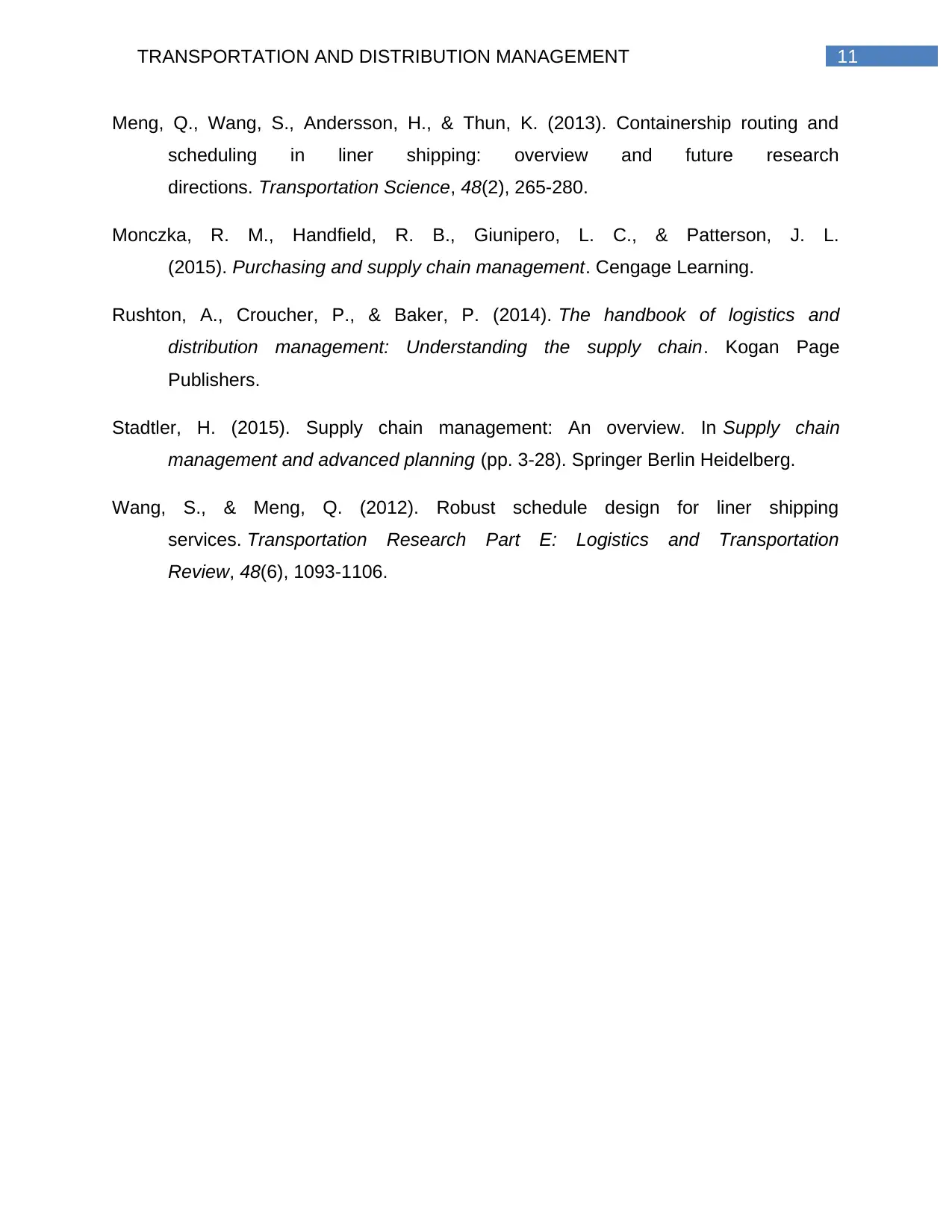
11TRANSPORTATION AND DISTRIBUTION MANAGEMENT
Meng, Q., Wang, S., Andersson, H., & Thun, K. (2013). Containership routing and
scheduling in liner shipping: overview and future research
directions. Transportation Science, 48(2), 265-280.
Monczka, R. M., Handfield, R. B., Giunipero, L. C., & Patterson, J. L.
(2015). Purchasing and supply chain management. Cengage Learning.
Rushton, A., Croucher, P., & Baker, P. (2014). The handbook of logistics and
distribution management: Understanding the supply chain. Kogan Page
Publishers.
Stadtler, H. (2015). Supply chain management: An overview. In Supply chain
management and advanced planning (pp. 3-28). Springer Berlin Heidelberg.
Wang, S., & Meng, Q. (2012). Robust schedule design for liner shipping
services. Transportation Research Part E: Logistics and Transportation
Review, 48(6), 1093-1106.
Meng, Q., Wang, S., Andersson, H., & Thun, K. (2013). Containership routing and
scheduling in liner shipping: overview and future research
directions. Transportation Science, 48(2), 265-280.
Monczka, R. M., Handfield, R. B., Giunipero, L. C., & Patterson, J. L.
(2015). Purchasing and supply chain management. Cengage Learning.
Rushton, A., Croucher, P., & Baker, P. (2014). The handbook of logistics and
distribution management: Understanding the supply chain. Kogan Page
Publishers.
Stadtler, H. (2015). Supply chain management: An overview. In Supply chain
management and advanced planning (pp. 3-28). Springer Berlin Heidelberg.
Wang, S., & Meng, Q. (2012). Robust schedule design for liner shipping
services. Transportation Research Part E: Logistics and Transportation
Review, 48(6), 1093-1106.
⊘ This is a preview!⊘
Do you want full access?
Subscribe today to unlock all pages.

Trusted by 1+ million students worldwide
1 out of 12
Related Documents
Your All-in-One AI-Powered Toolkit for Academic Success.
+13062052269
info@desklib.com
Available 24*7 on WhatsApp / Email
![[object Object]](/_next/static/media/star-bottom.7253800d.svg)
Unlock your academic potential
Copyright © 2020–2025 A2Z Services. All Rights Reserved. Developed and managed by ZUCOL.




